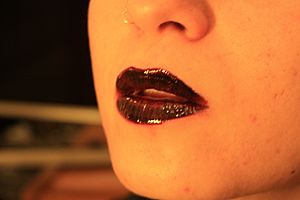Lipstick facts for kids
Lipstick is a type of makeup used on the lips. It helps make lips look shiny or adds color to them.
Contents
The History of Lipstick
Lipstick in Ancient Times
About 5,000 years ago, people in ancient Sumer might have been the first to use lipstick. They crushed shiny gemstones to color their faces, especially their lips and eyes. In Ancient Egypt, people like Cleopatra even crushed bugs to make red colors for their lips!
From about 3000 BC to 1500 BC, women in the ancient Indus Valley civilization also used red lipstick to decorate their faces. For Egyptians, lipstick showed how important someone was in society. They got red dye from plants and other things. But some of these dyes could make people very sick. Early lipsticks with a shimmering look were made using a shiny substance found in fish scales.
During the Islamic Golden Age, a smart cosmetologist named Abu al-Qasim al-Zahrawi invented solid lipsticks. These were scented sticks pressed into special molds. He wrote about them in his book Al-Tasrif.
The Chinese made some of the first lipsticks from beeswax over 1,000 years ago. These helped protect the delicate skin of the lips. During the Tang Dynasty (CE 618-907), they added nice-smelling oils to make lips even more appealing.
In Australia, Aboriginal girls would paint their mouths red with ochre. This was part of special rituals when they became teenagers.
Lipstick in the United Kingdom
Lip coloring started to become popular in 16th-century England. During the time of Queen Elizabeth I, bright red lips and a very white face were fashionable. Back then, lipstick was made from a mix of beeswax and red stains from plants. Only women from rich families and male actors wore makeup.
For most of the 19th century, wearing obvious makeup was not seen as proper for respectable women in Britain. It was mostly linked to groups like actors. In the 1850s, people started warning women about the dangers of using lead in face makeup.
By the end of the 19th century, Guerlain, a French makeup company, began making lipstick. The first commercial lipstick was invented in 1884 by perfumers in Paris, France. It was wrapped in silk paper and made from deer tallow, castor oil, and beeswax. Before this, people usually made their own lipstick at home.
Lipstick in the United States
In the 19th century, lipstick was colored with carmine dye. This dye came from cochineal insects, which live on cactus plants in Mexico and Central America. These insects produce a red acid that can be used to make carmine dye.
This early lipstick did not come in a tube. People applied it with a brush. Carmine dye was expensive, and the look of carmine lipstick was seen as unnatural. So, it was not worn for everyday use. Only actors and actresses usually wore lipstick. The famous actress, Sarah Bernhardt, started wearing lipstick and rouge in public. Before the late 19th century, women only put on makeup at home.
In the early 1890s, carmine was mixed with oil and wax. This mixture gave a more natural look and became more accepted by women. At that time, lipstick was not sold in a twist-up metal tube. It was sold in paper tubes, tinted papers, or small pots. The Sears Roebuck catalog first offered rouge for lips and cheeks by the late 1890s.

By 1912, fashionable American women thought lipstick was acceptable. However, a newspaper article advised them to apply it carefully.
By 1915, lipstick was sold in metal cylinder containers. These were invented by Maurice Levy. Women had to slide a tiny lever to move the lipstick up. In 1923, the first twist-up tube was patented by James Bruce Mason Jr. in Nashville, Tennessee. As women started wearing lipstick for photographs, photography helped make lipstick more popular. Famous makeup brands like Elizabeth Arden and Estee Lauder began selling lipstick in their stores.
During World War II, metal lipstick tubes were replaced by plastic and paper tubes. Lipstick was hard to find then because some key ingredients, like petroleum and castor oil, were not available. After the war, in the late 1940s, a chemist named Hazel Bishop created the first long-lasting lipstick. It was called No-Smear lipstick.
In the 1990s, a new type of lip color was invented. It was a wax-free, liquid formula that lasted a long time. Other companies have since made their own versions of these long-lasting "lip stains" or "liquid lip colors."
What's in Lipstick?
Lipstick contains wax, oils, antioxidants, and softeners. The wax gives the solid lipstick its shape. Many waxes can be used, such as beeswax, ozokerite, and candelilla wax. Carnauba wax is very important because it has a high melting point, which makes the lipstick strong. Different oils and fats are also used, like olive oil, mineral oil, cocoa butter, lanolin, and petrolatum.
Related Pages
Images for kids
-
Elizabeth Taylor helped popularize red lipstick.
-
Marilyn Manson helped popularize dark lipsticks in alternative subcultures.
-
Madonna during the film Evita with her Laura Mercier's "M" red lipstick; a shade created for Madonna for this film
-
Taylor Swift in her signature red lips, on Good Morning America in 2012.
See also
 In Spanish: Lápiz labial para niños
In Spanish: Lápiz labial para niños












